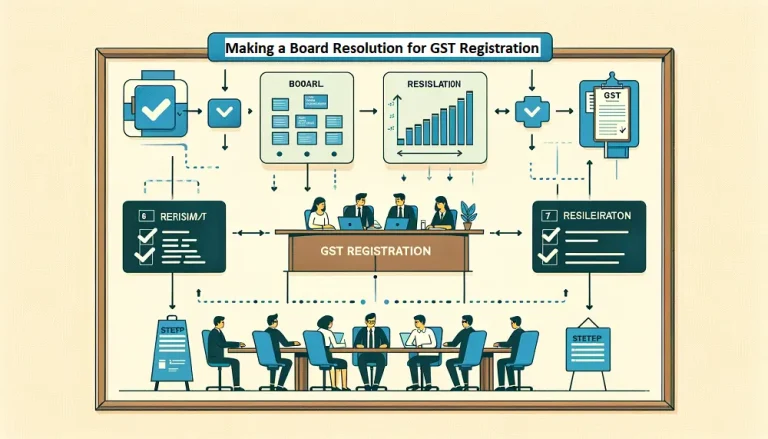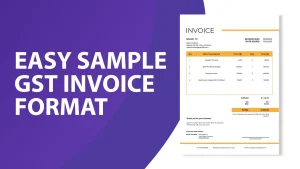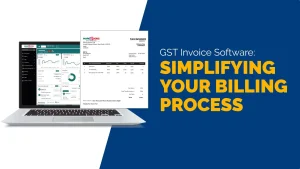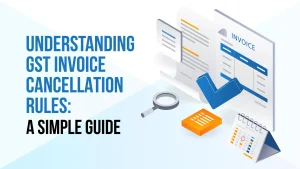When it comes to running a business, there are certain rules we need to follow. One important rule in India is getting registered for Goods and Services Tax (GST). To do this, we need something called a “Board Resolution.” In simple terms, a board resolution is like a special document that shows everyone is on the same page about getting registered for GST.
Understanding Board Resolution for GST Registration:
Think of a board resolution like a permission slip for adults. It’s a paper that says, “Hey, we, the leaders of the company, agree that we want to register for GST.” This is important because it shows the government that our company is serious about following the rules.
Components of Board Resolution Format for GST Registration:
Heading and Identification: Start the resolution with a big title that says “Board Resolution for GST Registration.” Write down the name of the company and its registration number. This helps everyone know which company this resolution belongs to.
Authorization Details: Next, we need to say who is the special person allowed to do the GST registration. Write down the name, job title, and maybe an employee number of that person. Think of it like saying, “Sarah is the one in charge of making sure we follow the GST rules.”
Resolution Text: Now, let’s talk about why we want to register for GST. We write a few sentences saying, “We, the leaders, think it’s a good idea to register for GST because it helps our company and makes everything fair.” Keep it simple and straightforward.
Approval and Signatures: Show that everyone in charge agrees with the decision. Get their signatures, which is like saying, “I’m okay with this decision.” If someone doesn’t agree, we write that down too, just so everyone knows.
Date and Record Keeping: Write down the date when we decided to register for GST. This helps keep track of everything. Also, keep a copy of this paper safe, like in a special folder, because we might need it later.
Letter of Authorisation for GST: Along with the board resolution, we might need a special letter that says, “Yes, Sarah has our permission to register for GST.” This letter is like a backup for the board resolution. It also needs signatures to make it official.
Common Challenges and Solutions:
Incomplete Information:
- Challenge: Imagine baking a cake without all the ingredients. Incomplete details in the resolution are like missing ingredients, making our GST story a bit confusing.
- Solution: Double-check the resolution. Is Sarah’s information complete? Did we mention why we’re excited about GST? Let’s ensure every detail is there, creating a complete and clear picture.
Understanding GST Implications:
- Challenge: Explaining GST can be like solving a puzzle. If our explanation is too complicated, it might feel like trying to solve a puzzle without all the pieces.
- Solution: Keep it as simple as telling a friend about a favorite game. Use everyday words – “GST is good for us, and we want to play by the rules.” Avoid jargon or complex terms, ensuring everyone understands our decision.
Approval and Signatures:
- Challenge: Picture this as a team not cheering together after a goal. If someone hasn’t signed, it’s like missing a cheerleader, and our resolution may not be as strong.
- Solution: Confirm that everyone in the boardroom has given their approval. Collect signatures like autographs after a great show. If there’s a different opinion, let’s note it respectfully, acknowledging everyone’s voice in our story.
Date and Record Keeping:
- Challenge: Forgetting to note the date is like not putting a timestamp on a special photo. It might make it hard to remember when our exciting GST journey began.
- Solution: Write down the date of our decision. Treat it like marking a special occasion in a calendar. Also, make sure to store a copy of our resolution in a safe place, just like keeping a cherished photo in an album.
Letter of Authorization for GST:
- Challenge: Imagine trying to open a treasure chest without the right key. If our letter of authorization is missing or unclear, it’s like not having that special key.
- Solution: Ensure our letter clearly states Sarah is our chosen one for GST. Think of it like giving her a golden key – a clear authorization to embark on the GST adventure. Keep it simple but powerful.
Conclusion:
So, getting registered for GST is a bit like getting a permission slip for grown-ups. The board resolution is our way of saying, “We’re in, and we’re following the rules.” Keep the paper safe, and if anyone asks, we can show them our special permission slip.
Frequently Asked Questions
What’s a Board Resolution?
A Board Resolution is a formal document that records decisions made by a company’s board of directors. It’s a crucial legal requirement for certain actions, like GST registration, showing official approval from the board.
Why is a Board Resolution needed?
It serves as evidence of the board’s authorization for significant decisions. For GST registration, it demonstrates that the company’s leadership has approved the application and its related responsibilities.
Who drafts a Board Resolution?
Typically, the company secretary or legal advisor drafts the resolution. They ensure it complies with legal requirements and accurately reflects the board’s decision regarding GST registration.
What information is included?
The resolution should state the company’s name, registration number, date, details of the decision (in this case, GST registration), and signatures of board members or their proxies.
When should a Board Resolution be made?
It’s necessary before applying for GST registration. Timing is crucial to ensure compliance and avoid delays in the registration process.
Who approves the Resolution?
The board of directors, or a designated committee if authorized, approves the resolution. Each member should understand and consent to the decision.
Can a Board Resolution be revoked?
Yes, it can be revoked or amended with the board’s agreement. However, such changes should be documented and filed accordingly.
Is a Board Resolution legally binding?
Yes, once approved and signed, a Board Resolution is legally binding. It represents the collective decision-making authority of the board.
What if a Board member dissents?
Dissenting opinions should be noted in the resolution, but the decision can still proceed if it’s approved by the majority of the board.
What happens after the Resolution?
Once finalized, the resolution should be kept in the company’s records. It will serve as proof of compliance during audits or legal inquiries regarding GST registration.





You are truly an accomplished webmaster. The site loads in an astounding amount of time. It appears that you are employing some sort of unique technique. Furthermore, the contents are flawless; you have accomplished an outstanding job on this subject.